The ride in was through construction and frankly poverty as yet unseen that conjured images of Beirut or . . . Somalia. Since the KTM was running on battery power I did not chance stopping to record any fairly uninspiring images.
But the hotel was incredibly close to Gur-e-Amir (Amir’s ACTUAL mausoleum) and even tired and a bit anxious about the KTM’s problem(s) (?) I got in some photos and sightseeing. And a nice, cold Baltika beer. (UZ beer is cheap but, if one can, you spend the extra 40 cents on a liter/quart of Russian import. :))
Since it appeared I’d be delayed getting to Tashkent for my new KZ Visa I decided to give in to spending as many as 5 days in Samarkand sorting the bike and seeing the sights and . . . getting caught up on rest. It now appears that Tashkent will be further complicated by some sort of athletic event as hotels are completely overbooked. I may try spending the night at a chaikana outside of the city on Sunday nite and then rushing to the the KZ Embassy on Monday AM. If they’ll return the Visa in the same day (quite possible) I may drive further on to the Fergana Valley and bypass Tashkent altogether.
And the potential necessity of staying at a chaikana is a good time to introduce the myriad perspectives one encounters when traveling (and really, almost anything else), that are . . . all, in their own way, true. Many of my fellow travelers are somewhat less enamored of UZ than I. They’ve flown 8,000+ kilometers and I’ve ridden. They’ve been largely constrained to tourist areas, tourist transportation options and tourists dining, viewing and touristic engagements with “locals”. I’ve had a bit of that. They’ve experienced so-so food and overcharging, some of it on a fairly egregious level. (Whether it’s a $2 or $20 overcharge it’s not a lot of money in the west, but when it’s five to 10 times what a local pays . . . it feels dirty.) My luck, good, not-so-good, and standard have placed me at the mercy and civility of locals since . . . the plane pulled up at Vancouver, BC. But even in the tourist centers I’ve had good luck finding or being pointed toward local flavor. I’ll flatter myself and say it’s the SF vibe people pick up on – food is KING sprinkled with a touch of “he smells like us” (from eating the same food . . . ) and therefore I don’t “seem” like another inappropriately dressed tour bus tourist. In any case, little or nothing in the way of “issues” I’ve heard do I think are whinging or fabricated. But that’s one of the reasons you travel overland, independently. You’re not a “local” but you’re certainly not one of the aliens who drops in and then lifts off after 30 minutes of snapshots and souvenir bargaining. In Urus-Krishlak I was confronted with sleeping in a field next to a road and was ready to do it. One thing about traveling by motorcycle – your exposure is not only on display, it’s impossible to hide. And that makes for a certain connection with “locals”.
On the first nite I had dinner at a 19th century Sufi home. The room we ate in was beautiful and the food decent, including the plov. Sufi’s had been major players in UZ life for over a 1,000 years but since the Tsarist takeover have declined dramatically. Soviet control effectively ended their time but independence (of some sort) has nearly eradicated knowledge of their contributions. Almost every house and home has some Sufi designs or relics but very few Uzbeks know what they are or assume they are simply “normal” Muslim artefacts/designs.
With Soviet oversight and collectivization the house was assumed by the State and put up for auction. It says something about the local community that no one would make a bid on it and so it became an impromptu homeless shelter for years. Unfortunately, between burning fires for heat, smoking and a lack of maintenance the house and room suffered considerable damage. It’s ironic that the Soviets were so imprisoned by their own dogma that in forced collectivization they completely failed to harness the mineral wealth of their colonies. And their environmental tinkering (eg, Aral Sea . . . ) – well, it makes the ‘god-less communists’ seem like they’d taken a biblical passage (Genesis 1:26) to heart – “let them have dominion over all living things (paraphrasing)”.
There ARE some sights in Samarkand. It’s often challenged or even re-viled for the sloppy or overdone way in which some of the restorations have been done. The Registan, at least the two new Medressas that Ulegbek (Timur’s grandson, who taught mathematics and was quite an avid astronomer) built. Timur’s contribution has required significantly less work after more than 500 years in a climate of extreme heat, sun and not a little cold and snow. This is true of many of the 500+ year old edifices. The workmanship is exceptional. But these came from a time when Islam was a center of learning and idea exchange, not an ever constricting orthodoxy. (Mind you, both Jesus and the Buddha had similar complaints about either a lack of debate and/or a thorough mis-reading of the scripture within Judaism and Hinduism, respectively.)
Now, many of the restorations have political AND religious motivations that I doubt would please the originators. This is, without a doubt, a global problem. Here the govt desires to contain and control the religion. And the religion, wants to sponsor questioning of the govt but stymie questioning of the religion. You can find people writing their own history or denying it in Burma, the former Yugoslavia, and even the Tea Party in the US. Here, the medressa’s are still GENERAL places of learning, not like in Afghanistan or Pakistan, etc.
But that’s not to say they produce graduates who have the scientific or engineering knowledge to restore properly, nevermind build something like the huge Bibi-Khanym Mosque, built for Timur’s chinese wife, which was one of the largest mosques in Islam for centuries and severely strained 15th century construction techniques. (It’s interesting to note that the HIGHEST (though definitely not of the greatest MASS) edifice in the western hemisphere until nearly 1600 were the temples at Tikal in southern Mexico/central America.)
But again, these are strange times and curiously hypocritical ones, too. A german and his spanish wife were mightily critical of “organic” produce at dinner the other nite. They were unable to DEFINE (in)-organic. But this did not chasten them from all but mocking science. They had an opinion and for all intents and purposes – that WAS their FACT. I enjoyed this perspective from folks who were benefitting from electricity (and lighting) in a 19th century room, who were both wearing optics made with the understanding of physics and engineered math, and that they did not refute their medications . . . Take your pick – “the devil can cite scripture” or a long-time favorite of mine – “patriotism is the last refuge of a scoundrel”.
The scientists are pretty good at criticizing their “work”. After all, they’ve little to “believe” (er, “faith”). Except the faith of the sceptic as the path to either answers or understanding. I’ve as much frustration with physicists who “find” new sub-atomic particles, but gain no insights, or play parlour games with mathematics to “solve” an understanding as anyone. But if the, ahem, un-educated, are so eager to mock things – let them try pre-20th century life. For a week. No fridge. No TV. No phone, landline or mobile. No running water and when it does “run”, no hot water. No car. No medicine. Pardon me, but “religion” poked the eyes out of a man (Galileo) who had the temerity to speak a fairly obvious truth regarding the position of the Earth in the Universe. “Science” has had a very short run and NUMEROUS advances. Religion (or just deliberate ignorance) ? (Not conflating ignorance with religion, btw.)
Consider Islam. It’s easily the newest of the Abrahamic traditions and has SOARED to heights in number of followers, teaching and creativity in a very short period. But other than number of followers what has happened occurred when it was open, and, dare I say, scientifically skeptical. And now ? All the faith in the world won’t build any of those amazing edifices, whether the Registan, the Taj Mahal, or the Alhambra.
And it wouldn’t help me fix the KTM’s battery “issue”. Dang it.
But what did help me was a Muslim who took me around to just one shop and another garage. At the shop I was able to purchase crude but suitably heavy gauge wire. At the garage the guys did some minor trimming and drilling should I need to join lengths to make a longer cable. UZ has a 70’s feel in that EVERYONE asks how high the speedo goes on the KTM and by association how “fast”. Then they asked me if it could go THAT fast in UZ. They laughed hysterically when I answered ‘NO !’.
Two hours later I had positive indications that the starter motor was alright and that I could at least limp into Tashkent for a different battery if prudent.
So more sightseeing was in order and my first goal was to try to secure a ticket for a concert by an Uzbek artist known as ‘Sultan Ali’ (in Tajik ‘Sato Ali’). He’s definitely a modern fusion artist, using old (10+ violins in his ensemble) and new instruments (electric guitar, keyboard, drum machine) to wrap Uzbek folk songs with modern techniques for producing rhythms. It was an interesting concert lasting over 2 hours. The music was solid though not as enjoyable as the stuff I’d heard in Bukhara from him. He knew how to work the crowd very well. And it was all completely choreographed. EVERYONE knew when it was the last song and then a very obligatory showering of bouquets but patrons followed. The crowd was poorly behaved, another increasingly global symptom, talking loudly during the entire show – even the people recording video on their phones would talk loudly while recording ! They had no idea about rhythm transitions or seques – clapping and whistling loudly at the slightest down volumes . . . clearly not experienced concert goers. (This “show” happens once every two years and normally in August.) The sound mix was decidedly a bit harsh on the high frequencies, though I’m sure it wasn’t just the sound man – I saw the REALLY bad chinese copies of the UK sound system the next day.
I don’t know how Timur would have felt about a light show blasting abstract designs in laser light on the Registan. Nor do I think he would have been thrilled by Sultan Ali’s discussion about “different people”. Sultan Ali’s pronouncements concerned MUSLIMS of different backgrounds (Arabs, Kazakhs, Turks, Tajiks, etc) not ALL people. Timur had a Chinese wife. He believed in general education, not just religious education. He had no favoritism for artists who were Muslim. He presided over an empire from Kashgar to Egypt that made easy and considerable room for other faiths and approaches, including a Bukhara that had a population that was more than 10% Jewish. Now Uzbeks don’t even have Sufis (“mystic” Muslims) in their midsts.
The Registan was interesting to video and photo with all the sound equipment and stages and crowd seating. But I look forward to Friday when that’s all gone and I can wander in peace. The Glorious Maximum Leader had the streets closed off for the concert, a huge police presence and full scanners for security. This all for a crowd of not more than 400 people.
The Registan IS a tremendous view and presence. And Bibi-Khanym Mosque IS gigantic and imposing. The modernized Siob Bazaar is rather sad – there are interesting things for sale and great views of ethnic variety (UZ is really starting to remind me of California – eye/hair/skin color mix is definitely a cocktail “shaken not stirred”) but there are TONS of crappy chinese junk for sale. And the area between the Registan and Bibi-Khanym is lined with opposite rows of stores all offering the same tourist stuff sold at the bazaar for much more in a country that really sees very few tourists. There’s not a single international brand outlet in sight. There is a pharmacological clinic in the middle of all the tourist vendors just opposite a very expensive private children’s school. The clinic has appropriated the look of a medressa. How subtle. One morning women in nurses outfits, with masks in place, were out sweeping the way in front.
The Gur-e-Amir mausoleum is lovely. Timur’s “accidental” final resting place, it’s almost too dear for the “original Texan”. (Again, my favorite story about Timur follows. Having vanquished another city he took all the artisans into his personal “protection” where they were “offered” the freedom to please Timur. One man, apparently unfamiliar with Timur’s sense of grand scale, made him a Koran that required a magnifying glass to read, such was the skill of his craft. TImur threw him in prison for 7 years. When he came out he completed a Koran that required a ladder to mount and read. Timur like. :))
But without a doubt, the most memorable, most intimate sight is the Shah-i-Zinda collection of mausoleums. Astonishing tile quality and, again, the ones built between 500-600 years ago have required much less restoration such is the quality of their work, both structurally and decoratively – when Islam was particularly open to other ideas and perspectives and when the great medressas taught hard science, too.

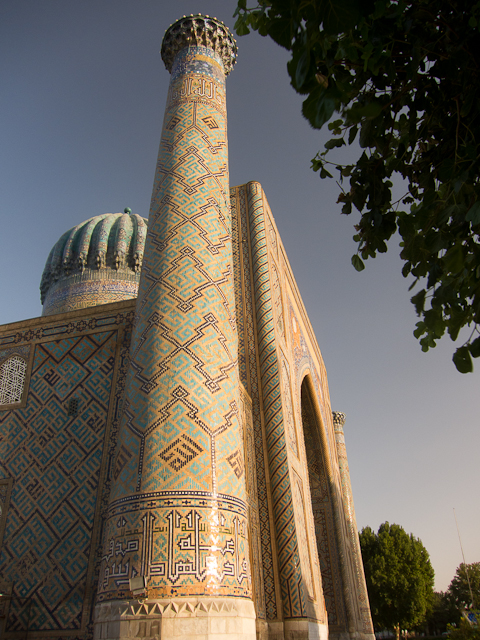

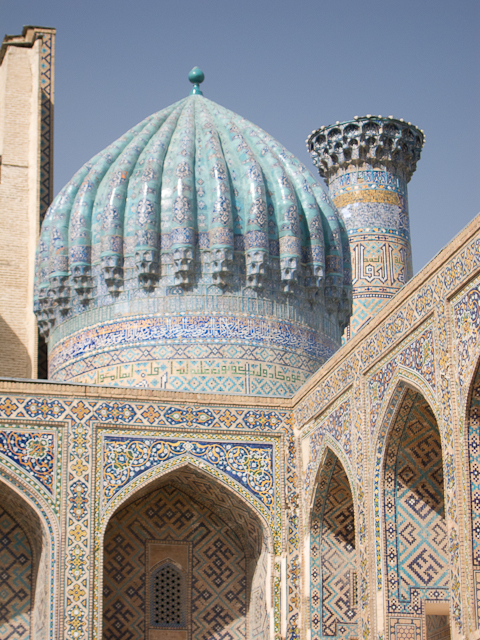



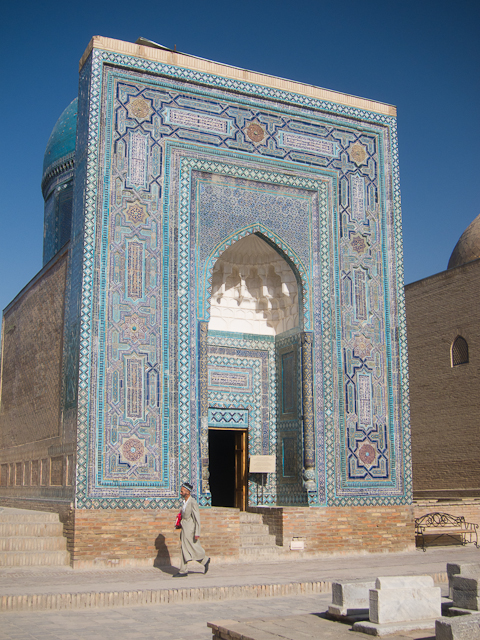






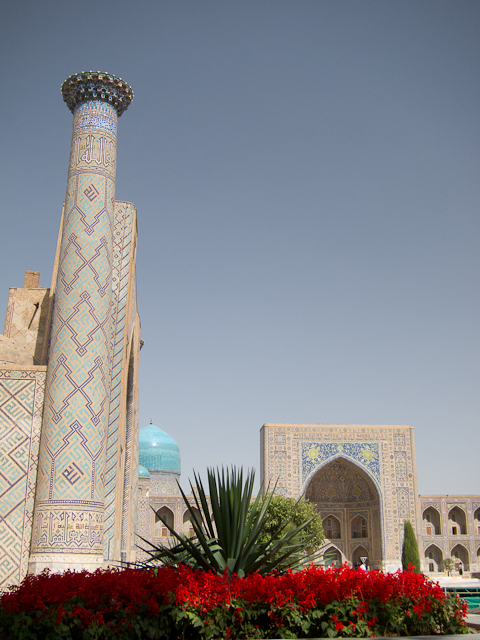


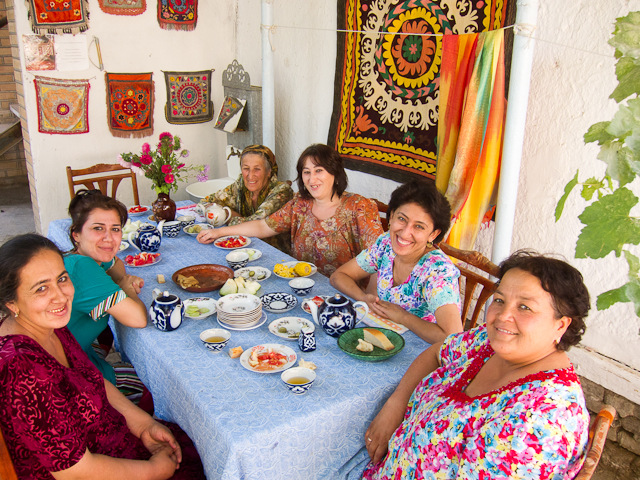
3 Responses to Samarkand